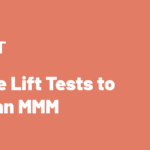Attribution systems break at scale because they can’t measure causality. As businesses grow more complex, they often fall into what we call the ‘inaction and panic cycle.’
- First, they set up a measurement system based on last-touch attribution or platform ROAS.
- Then, when business pressure increases, they look at their reports, cut the low-ROAS channels (typically your upper-funnel investments), and watch as growth inevitably slows.
- Despite better-looking ROAS numbers, they’re left optimizing toward easily trackable channels rather than those truly driving incremental growth.
This article explains why attribution fails – and how to replace it with an incrementality system built for modern growth.
Attribution is not incrementality.
First, let’s define our terms.
Attribution systems–whether last-touch, first-touch, or multi-touch–assign credit for conversions based on observable user behavior. They work by mapping a conversion event backward through known interactions (clicks, views, sessions), then distributing credit according to a predefined rule set or algorithm.
But they do not account for counterfactuals: what would have happened in the absence of the marketing touchpoint.
That’s the core difference. Attribution is about assigning credit for conversions to marketing touchpoints. Incrementality is about measuring causality: what actually caused the lift in performance.
That distinction matters–a lot.
Now, in the very early stages of a company, when a brand has little to no baseline demand, those two things often appear aligned. If you’ve just launched a product and turned on Meta ads, it’s plausible to assume that nearly all of your conversions are ad-driven.
There is minimal organic awareness, negligible word of mouth, and no material repeat behavior. In that narrow context, even biased attribution data (e.g., Meta-reported ROAS) can serve as a functional proxy for incrementality because the alternative (what would have happened without marketing) is close to zero. Your Meta dashboard’s ROAS estimate isn’t perfect, but it’s directionally useful.
But this clarity doesn’t last. As the business grows, complexity creeps in:
- You layer in more channels: influencers, YouTube, podcasts, linear TV, and programmatic display.
- You expand your distribution: Amazon, mass retail, and wholesale.
- Your brand starts to work. People hear about you from friends. They Google your name. They come in through organic search, direct, and email.
Suddenly, attribution models that once felt reliable begin to break down. Touchpoints multiply. Customer journeys lengthen. The assumptions that underpin your tracking infrastructure–like the idea that conversions can be deterministically tied back to observable interactions–start to fall apart.
Clicks no longer equal cause. The marginal impact of each paid channel becomes harder to isolate. And attribution systems, which are built to assign credit, not measure impact, start telling stories that no longer align with reality.
That’s when you need to graduate to more sophisticated measurement, because the cost of flying blind is no longer trivial.
The exact breaking points of attribution at scale.
For brands operating across multiple channels, attribution doesn’t just lose precision – it becomes structurally misleading.
The issues are no longer just concerning visibility or missing data. They’re fundamental limitations in how attribution models assign credit and the assumptions they rely on–assumptions that don’t hold up in scaled, omnichannel environments.
Here’s where it starts to break:
1. Branded search gets over-credited
If someone searches your brand name on Google and clicks an ad, most attribution systems will give full credit to paid search. But branded search is often a downstream effect of prior marketing activity–TV, PR, influencer, podcast, even offline WOM. These upper- and mid-funnel channels drive interest, but attribution logic gives the credit to the last measurable click.
2. Retargeting looks more effective than it is
Retargeting campaigns focus on users who have already expressed interest. These users have higher baseline conversion rates. So when an attribution model sees a conversion post-retargeting, it assumes the ad caused it, when in reality, the conversion might have happened anyway. That’s selection bias in action.
3. Platform bias distorts reality
Meta and Google each report conversions through their own measurement lenses. Both use black-box attribution logic (especially when SKAN or modeled conversions are involved), and both operate in isolation. As a result, they can each claim credit for the same conversion. From a marketer’s perspective, your platforms are collectively overreporting performance, and no one’s telling you how much overlap exists.
4. Offline and retail sales vanish from view
If 30–40% of your sales happen through Amazon or Target, those conversions likely won’t show up in your attribution systems. That means your models are optimizing toward your ecommerce channel, potentially underinvesting in the marketing that drives total brand sales, including those you can’t track digitally.
5. Cross-channel contamination muddles signal
Influencer marketing often bleeds into paid social performance. Podcasts drive direct and organic traffic. TV boosts branded search. When multiple channels touch the same user within a short timeframe, deterministic attribution models struggle to de-dupe and disentangle causal chains. The more integrated your media mix becomes, the more it confuses systems designed to measure discrete, linear journeys.
6. Attribution windows are arbitrarily defined
Most attribution models rely on fixed windows (e.g., 7-day or 28-day post-click). But the true impact duration of a channel varies–TV might have long-lag effects; search might convert instantly. When attribution systems impose rigid windows, they truncate long-term impact or misattribute short-term behavior.
None of these issues are edge cases. They’re structural. They emerge precisely when a business becomes large enough to operate across multiple channels and touchpoints.
Attribution didn’t break because your data got messy. It broke because your system isn’t built to answer the question you’re now asking:
What’s actually driving incremental performance?
The incrementality system: how modern marketing teams actually win.
So what’s the alternative?
We believe the solution isn’t just a better attribution model or a faster MMM report. What marketing leaders actually need is a new system–one designed from the ground up to reflect the realities of how modern marketing actually works.
We call it the Incrementality System.
The incrementality system isn’t a tool or a model. It’s an operating framework – a way of running a modern marketing organization that continuously plans, experiments, validates, and optimizes. It’s designed to connect marketing investments to business outcomes – not just retrospectively through reporting, but proactively through real-time decision-making.
Here’s how it works:
Plan
Start with the most fundamental question any marketing leader faces: what should we do next to drive the business forward? This means identifying opportunities, setting expectations, and aligning marketing actions with business goals. But more importantly, it means documenting the assumptions behind every decision, because those assumptions are what you’ll test next.
Experiment
Every part of your plan is a hypothesis. Which channels to invest in? What audiences to target? What messages to scale? Treat them that way. Testing isn’t a side project–it’s a core operating function. A healthy marketing org is always probing: What if we double-spend on CTV? What happens if we turn off branded search? How far can we scale influencers before returns drop?
Validate
Once you test, you need to measure. Did the tactic perform as expected? Did the lift actually materialize? This is where incrementality comes into play. Whether you’re using geo-experiments, modeled lift, or observational analysis, the goal is the same: confirm or disprove your assumptions and quantify the real business impact.
Optimize
Close the loop. Feed what you’ve learned back into the planning cycle. Reallocate budget toward proven winners. Cut or revise underperformers. And most importantly, let your validated learnings shape future strategy. Every test should make the next plan smarter.
This cycle doesn’t happen once a quarter. It’s continuous. Always running. Always refining. It’s how you escape the attribution doom loop – and start building a marketing function that can adapt to change, earn trust from finance, and drive long-term growth.
At Recast, we built our platform from the ground up to support this type of incrementality system. Traditional MMM vendors were too slow and clunky for brands that need to make decisions now, not in six months. Our approach focuses on faster, more efficient, more robust modeling technology that helps brands eliminate wasted marketing spend, optimize their channel mix, and generate reliable forecasts–all while supporting the continuous Plan-Experiment-Validate-Optimize cycle.
TLDR:
- Attribution isn’t going to catch up with the way modern marketing actually works. But the good news is – you don’t need it to.
- By shifting your team’s mindset toward incrementality and building a system that tests, learns, and optimizes continuously, you can stop chasing perfect reporting and start making better decisions.



